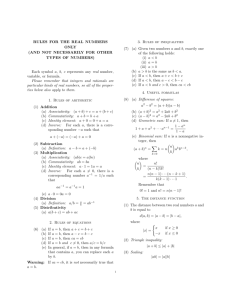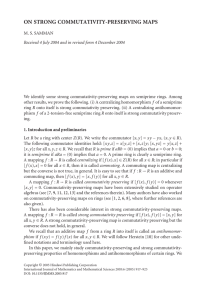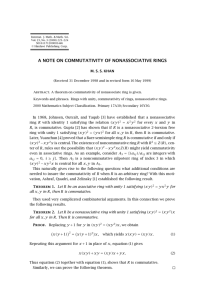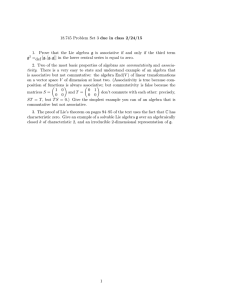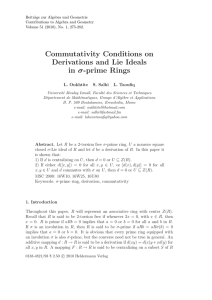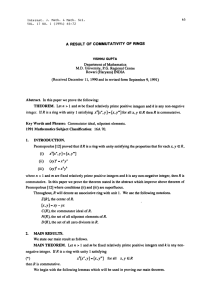Beitr¨ age zur Algebra und Geometrie Contributions to Algebra and Geometry
advertisement
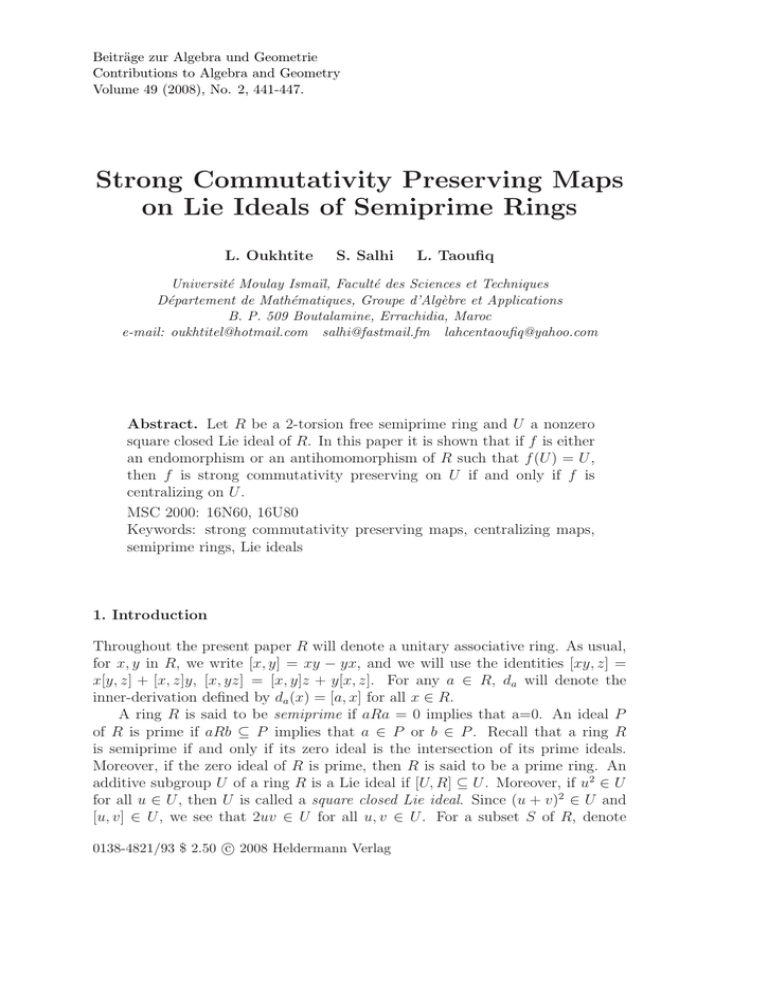
Beiträge zur Algebra und Geometrie
Contributions to Algebra and Geometry
Volume 49 (2008), No. 2, 441-447.
Strong Commutativity Preserving Maps
on Lie Ideals of Semiprime Rings
L. Oukhtite
S. Salhi
L. Taoufiq
Université Moulay Ismaı̈l, Faculté des Sciences et Techniques
Département de Mathématiques, Groupe d’Algèbre et Applications
B. P. 509 Boutalamine, Errachidia, Maroc
e-mail: oukhtitel@hotmail.com salhi@fastmail.fm lahcentaoufiq@yahoo.com
Abstract. Let R be a 2-torsion free semiprime ring and U a nonzero
square closed Lie ideal of R. In this paper it is shown that if f is either
an endomorphism or an antihomomorphism of R such that f (U ) = U ,
then f is strong commutativity preserving on U if and only if f is
centralizing on U .
MSC 2000: 16N60, 16U80
Keywords: strong commutativity preserving maps, centralizing maps,
semiprime rings, Lie ideals
1. Introduction
Throughout the present paper R will denote a unitary associative ring. As usual,
for x, y in R, we write [x, y] = xy − yx, and we will use the identities [xy, z] =
x[y, z] + [x, z]y, [x, yz] = [x, y]z + y[x, z]. For any a ∈ R, da will denote the
inner-derivation defined by da (x) = [a, x] for all x ∈ R.
A ring R is said to be semiprime if aRa = 0 implies that a=0. An ideal P
of R is prime if aRb ⊆ P implies that a ∈ P or b ∈ P . Recall that a ring R
is semiprime if and only if its zero ideal is the intersection of its prime ideals.
Moreover, if the zero ideal of R is prime, then R is said to be a prime ring. An
additive subgroup U of a ring R is a Lie ideal if [U, R] ⊆ U . Moreover, if u2 ∈ U
for all u ∈ U , then U is called a square closed Lie ideal. Since (u + v)2 ∈ U and
[u, v] ∈ U , we see that 2uv ∈ U for all u, v ∈ U . For a subset S of R, denote
c 2008 Heldermann Verlag
0138-4821/93 $ 2.50 442
L. Oukhtite et al.: Strong Commutativity Preserving Maps . . .
by annR (S) the two-sided annihilator of S, i.e. {x ∈ R/Sx = xS = {0}}. For
every ideal J of a semiprime ring R, it is known that annR (J) is invariant under
all derivations and J ∩ annR (J) = 0.
A map f : R −→ R is centralizing on S if [f (x), x] ∈ Z(R) for all x ∈ S; in
particular if [f (x), x] = 0 for all x ∈ S, then f is called commuting on S.
A map f : R −→ R is called commutativity preserving on S if [f (x), f (y)] = 0
whenever [x, y] = 0, for all x, y ∈ S. In particular, if [f (x), f (y)] = [x, y] for
all x, y ∈ S, then f is called strong commutativity preserving on S. Recently,
M. S. Samman [4] proved that an epimorphism of a semiprime ring is strong commutativity preserving if and only if it is centralizing on the entire ring. Moreover,
he proved that if R is a 2-torsion free semiprime ring, then a centralizing antihomomorphism of R onto itself must be strong commutativity preserving. The
purpose of this paper is to extend the results of [4] to square closed Lie ideals.
2. Preliminaries and results
In order to prove our main theorems, we shall need the following results.
Lemma 1. Let R be a 2-torsion free semiprime ring and U a nonzero Lie ideal
of R. If [U, U ] = 0, then U ⊆ Z(R).
Proof. Let u ∈ U ; since [u, rt] ∈ U for all r, t ∈ R, then [u, [u, rt]] = 0. Hence
u[u, rt] = [u, rt]u. Therefore
ur[u, t] + u[u, r]t = r[u, t]u + [u, r]tu.
As u[u, r] = [u, r]u and [u, t]u = u[u, t], then
ur[u, t] + [u, r]ut = ru[u, t] + [u, r]tu.
It follows that 2[u, r][u, t] = 0 for all u ∈ U and r, t ∈ R. Since R is 2-torsion free,
thus
[u, r][u, t] = 0, for all u ∈ U and r, t ∈ R.
(1)
Replace t by sr in (1) to get [u, r]R[u, r] = 0 for all u ∈ U, r, t ∈ R. The fact R is
semiprime implies that U ⊆ Z(R).
In all that follows U will be a square closed Lie ideal of R and M will denote the
ideal of R generated by [U, U ], that is M = R[U, U ]R.
Lemma 2. Let R be a 2-torsion free semiprime ring and d a derivation of R. If
a in R satisfies ad(U ) = 0, then ad(M ) = 0.
R
is prime.
P
If [U, U ] ⊆ P or char(R) = 2, then 2ad(R)M ⊆ P and 2M ad(R) ⊂ P . Assume
now that [U, U ] 6⊂ P and char(R) 6= 2. The fact that R is 2-torsion free and
ad(U ) = {0} implies that aU d(v) = {0} for all v ∈ U and thus āU d(U ) = 0̄.
Proof. Let P be an arbitrary prime ideal of R, and note that R =
L. Oukhtite et al.: Strong Commutativity Preserving Maps . . .
443
As [U, U ] 6⊂ P , then U 6⊂ Z(R̄). Since [U , U ] 6= 0̄ from [4, Lemma 4] either
d(U ) = 0̄ or ā = 0̄, that is d(U ) ⊆ P or a ∈ P . If d(U ) ⊆ P , then d[r, u] ∈ P
for all r ∈ R and u ∈ U . Replace r by rv, where v ∈ U , to get d(R)[U, U ] ⊆
P . Thus d(R)R[U, U ] ⊆ P which yields d(R) ⊆ P because [U, U ] 6⊂ P . In
conclusion ad(R) ⊆ P . Consequently, ad(R)M ⊆ P and M ad(R) ⊆ P . We
now know that 2ad(R)M ⊆ P and 2M ad(R) ⊆ P for all prime ideals P of
R, hence 2ad(R)M = 2M ad(R) = {0}. By 2-torsion-freeness we conclude that
ad(R)M = M ad(R) = {0}. If we set J = annR (annR (M )), thenT obviously
ad(R)J = 0. Since R is semiprime, then d(J) ⊆ J so that ad(J)
T ⊆ J annR (J).
Once again using the semiprimeness of R, we conclude that J annR (J) = 0 so
that ad(J) = 0. Since M ⊆ J, this leads us to ad(M ) = 0.
Lemma 3. Let R be a 2-torsion free semiprime ring. If z ∈ U is such that
z[U, U ] = 0, then [z, U ] = 0.
Proof. If [U, U ] = 0, then U ⊆ Z(R) by Lemma 1 and therefore [z, U ] = 0. Now
suppose that [U, U ] 6= 0; from z[U, U ] = 0 we get zdu (v) = 0 for all u, v ∈ U .
Using Lemma 2, we find that zdu (x) = 0 for all u ∈ U, x ∈ M = R[U, U ]R. But
zdu (x) = 0 assures that zdx (u) = 0 for all u ∈ U, x ∈ M and once again using
Lemma 2, we get zdx (M ) = 0, for all x ∈ M . Hence zdx (y) = 0 for all x, y ∈ M
and thus
z[x, y] = 0 for all x, y ∈ M.
Replace y by yz to get zy[x, z] = 0, so that zM [x, z] = 0. In view of zxM [x, z] = 0,
we then obtain [x, z]M [x, z] = 0. Since an ideal of a semiprime ring is semiprime,
[x, z] = 0 for all x ∈ M . As R[U, U ] ⊆ M , then [z, r[u, v]] = 0 for all r ∈ R, u, v ∈
U . Using [u, v] ∈ M , it then follows that [z, r][u, v] = 0. Replace r by rs in
the least equality, we find that [z, r]s[u, v] = 0 so that [z, r]R[u, v] = 0, for all
u, v ∈ U, r ∈ R. In particular [z, v]R[z, v] = 0, proving [z, v] = 0 for all v ∈ U
and thus [z, U ] = 0.
Now we are ready for our first theorem.
Theorem 1. Let R be a 2-torsion free semiprime ring and U a nonzero square
closed Lie ideal of R. Suppose that f is an endomorphism of R such that f (U ) =
U . Then f is strong commutativity preserving on U if and only if f is centralizing
on U .
Proof. From [x, 2xy] = [f (x), f (2xy)] for all x, y ∈ U , it follows that (x −
f (x))[x, y] = 0 for all x, y ∈ U . Replacing y by 2uy where u, y ∈ U , we get
(x − f (x))U [x, y] = 0 for all x, u ∈ U.
(2)
As 2[U, U ]R ⊆ U (because 2[u, v]r = 2[u, vr] − 2v[u, r]), then (2) implies that
(x − f (x))[U, U ]R[x, y] = 0 for all x, y ∈ U.
(3)
444
L. Oukhtite et al.: Strong Commutativity Preserving Maps . . .
Let P be an arbitrary prime ideal of R. It follows from (3) that for each x ∈ U ,
either (x − f (x))[U, U ] ⊆ P or [x, U ] ⊆ P . The two sets of elements of U for
which these conditions hold are additive subgroups of U whose union is U , hence
one must be equal to U . Therefore (x − f (x))[U, U ] ⊆ P for all x ∈ U and all
prime ideals P , i.e., (x − f (x))[U, U ] = {0} for all x ∈ U . Since f (U ) ⊆ U , then
u − f (u) ∈ U for all u ∈ U and Lemma 3 yields
[u − f (u), v] = 0 for all u, v ∈ U.
Consequently, [f (u), u] = 0 for all u ∈ U so that f is commuting on U .
Accordingly, f is centralizing on U .
Conversely, suppose that [f (x), x] ∈ Z(R) for all x ∈ U . By linearization
[x, f (y)] + [y, f (x)] ∈ Z(R) for all x, y in U . Using [x, f (x2 )] + [x2 , f (x)] ∈ Z(R)
together with 2-torsion-freeness, we find that (x + f (x))[x, f (x)] ∈ Z(R), for all
x ∈ U . Hence [(x + f (x))[x, f (x)], x] = 0 and therefore [x, f (x)]2 = 0. Since
[x, f (x)] in Z(R), this yields [x, f (x)]R[x, f (x)] = 0 and the semiprimeness of R
forces
[x, f (x)] = 0 for all x ∈ U.
Thus f is commuting on U and therefore [f (x), y] = [x, f (y)] for all x, y ∈ U . As
R is 2-torsion free, then [f (x), xy] = [x, f (xy)] and thereby (f (x) − x)[f (x), y] = 0
for all x, y ∈ U . Replacing y by 2uy where u ∈ U , we get (f (x) − x)u[f (x), y] = 0,
so that (f (x) − x)U [x, f (y)] = 0. Since f (U ) = U , then (f (x) − x)U [x, y] = 0 for
all x, y ∈ U . From 2[U, U ]R ⊆ U , it then follows that
(f (x) − x)[U, U ]R[x, y] = 0 for all x, y ∈ U.
Reasoning as in the first part of the proof, we find that [f (z) − z, u] = 0 for
all z, u ∈ U , and therefore [f (z), u] = [z, u], for all z, u ∈ U . Consequently, for
y, z ∈ U , this leads us to [f (z), f (y)] = [z, f (y)] = [z, y], proving that f is strong
commutativity preserving on U .
Remark. From the proof of Theorem 1, one can easily see that the condition
f (U ) ⊆ U is sufficient to prove that f is strong commutativity preserving implies
that f is commuting on U and therefore centralizing on U .
We easily derive the Proposition 2.1 of [4], for 2-torsion free semiprime rings, as
a corollary to Theorem 1.
Corollary 1. Let f be an epimorphism of a 2-torsion free semiprime ring R.
Then f is strong commutativity preserving if and only if f is centralizing.
In [3] it is proved that if R is a 2-torsion free prime ring and T an automorphism
of R which is centralizing on a Lie ideal U of R and nontrivial on U , then U
is contained in the center of R. Accordingly, in the special case when U = R,
Theorem 2 gives a commutativity criterion as follows.
L. Oukhtite et al.: Strong Commutativity Preserving Maps . . .
445
Corollary 2. Let f be a nontrivial automorphism of a 2-torsion free prime ring
R. If f is strong commutativity preserving, then R is commutative.
To end this paper, the following theorem gives a condition under which an antihomomorphism becomes strong commutativity preserving.
Theorem 2. Let R be a 2-torsion free semiprime ring and U a square closed Lie
ideal of R. If f is an antihomomorphism of R such that f (U ) = U , then f is
centralizing on U if and only if f is strong commutativity preserving on U .
Proof. Suppose [U, U ] 6= 0 and then M = R[U, U ]R is a nonzero ideal of R. If f is
centralizing on U , then reasoning as in the proof of Theorem 1 we find that f is
commuting on U , so that [f (x), y] = [x, f (y)] for all x, y ∈ U . Since R is 2-torsion
free, using [f (x), 2xy] = [x, f (2xy)] together with f (U ) = U we get
x[x, y] = [x, y]f (x) for all x, y ∈ U.
(4)
Replace y by 2uy in (4), where u ∈ U , and once again using 2-torsion-freeness, we
get [x, u][x, y + f (y)] = 0. Write 2uv instead of u in this equality, with v ∈ U , to
find that [x, u]v[x, y + f (y)] = 0. Hence
[x, u]U [x, y + f (y)] = 0 for all x, u, y ∈ U.
(5)
Since f (U ) ⊆ U , replacing u by y + f (y) in (5), we conclude that
[x, y + f (y)]U [x, y + f (y)] = 0 for all x, y ∈ U.
(6)
If we set T (U ) = {x ∈ R/[x, R] ⊆ U }, then [T (U ), R] ⊆ U ⊆ T (U ) and
from ([2], Lemma 1.4, p. 5) it follows that T (U ) is a subring of R. Moreover, R[T (U ), T (U )]R ⊆ T (U ). Indeed, let x, y ∈ T (U ) and r ∈ R. From
[x, yr] = [x, y]r + y[x, r] ∈ T (U ) and y[x, r] ∈ T (U ) it follows that [x, y]r ∈ T (U ).
Since [T (U ), R] ⊆ T (U ), then
[[x, y]r, s] = [x, y]rs − s[x, y]r ∈ T (U ) for all r, s ∈ R;
and therefore s[x, y]r ∈ T (U ) so that R[T (U ), T (U )]R ⊆ T (U ). In particular
R[U, U ]R ⊆ T (U ), which proves that [M, R] ⊆ U , where M = R[U, U ]R.
In view of (6), if we set [x, y + f (y)] = a then aU a = 0. Let u ∈ U, m ∈ M
and r ∈ R; from [mau, r] ∈ [M, R] ⊆ U it follows that
0 = a[mau, r]a = a[ma, r]ua + ama[u, r]a = a[ma, r]ua = amarua,
so that amaRua = 0. Using 2am ∈ 2[U, U ]R ⊆ U , Lemma 1.4, we get amaRama =
0, hence aM a = 0. Since a ∈ M , we obviously get a = 0, which implies that
[f (x), y] = [y, x], for all x, y ∈ U . Accordingly,
[f (x), f (y)] = [f (y), x] = [x, y] for all x, y ∈ U,
446
L. Oukhtite et al.: Strong Commutativity Preserving Maps . . .
proving that f is strong commutativity preserving on U .
Conversely, if f is strong commutativity preserving on U , then
[f (x), f (y)] = [x, y], for all x, y ∈ U.
(7)
Replace y by 2xy in (7) we obtain
x[x, y] = [x, y]f (x).
(8)
Write 2uy instead of y in (8), where u ∈ U , to find that
xu[x, y] + x[x, u]y = u[x, y]f (x) + [x, u]yf (x).
Since x[x, u]y = [x, u]f (x)y and [x, y]f (x) = x[x, y], by (8), then
xu[x, y] + [x, u]f (x)y = ux[x, y] + [x, u]yf (x)
and therefore
[x, u][x + f (x), y] = 0 for all x, y, u ∈ U.
(9)
Replacing y by x in (9), we obtain
[x, u][x, f (x)] = 0 for all x, u ∈ U.
(10)
As f (U ) ⊆ U , write 2f (x)u instead of u in (10) to get [x, f (x)]u[x, f (x)] = 0 and
thus
[x, f (x)]U [x, f (x)] = 0.
If we set a = [x, f (x)], then aU a = 0 and a ∈ M = R[U, U ]R. Reasoning as in the
first part of our proof, we conclude that a = 0 so that [x, f (x)] = 0. Accordingly,
f is commuting on U and therefore f is centralizing on U .
Remark. In the particular case when U = R, the implication that f is strong
commutativity preserving implying that f is centralizing is still valid without
conditions on characteristic of R.
In [4], Proposition 2.4 M. S. Samman proved that if R is a 2-torsion free semiprime ring, then a centralizing antihomomorphism of R onto itself must be strong
commutativity preserving. Applying Theorem 2, we obtain a more general result
as follows:
Corollary 3. Let R be a 2-torsion free semiprime ring. If f is an antihomomorphism of R onto itself, then f is centralizing if and only if f is strong commutativity preserving.
L. Oukhtite et al.: Strong Commutativity Preserving Maps . . .
447
References
[1] Bergen, J.; Herstein, I. N.; Kerr, J. W.: Lie ideals and derivations of prime
rings. J. Algebra 71 (1981), 259–267.
Zbl
0463.16023
−−−−
−−−−−−−−
[2] Herstein, I. N.: Topics in ring theory. University of Chicago Press, Chicago
1969.
Zbl
0232.16001
−−−−
−−−−−−−−
[3] Mayne, J.: Centralizing automorphisms of Lie ideals in prime rings. Can.
Math. Bull. 35 (1992), 510–514.
Zbl
0784.16023
−−−−
−−−−−−−−
[4] Samman, M. S.: On strong commutativity preserving maps. Int. J. Math.
Math. Sci. 2005(6) (2005), 917–923.
Zbl
1077.16037
−−−−
−−−−−−−−
Received May 31, 2007
